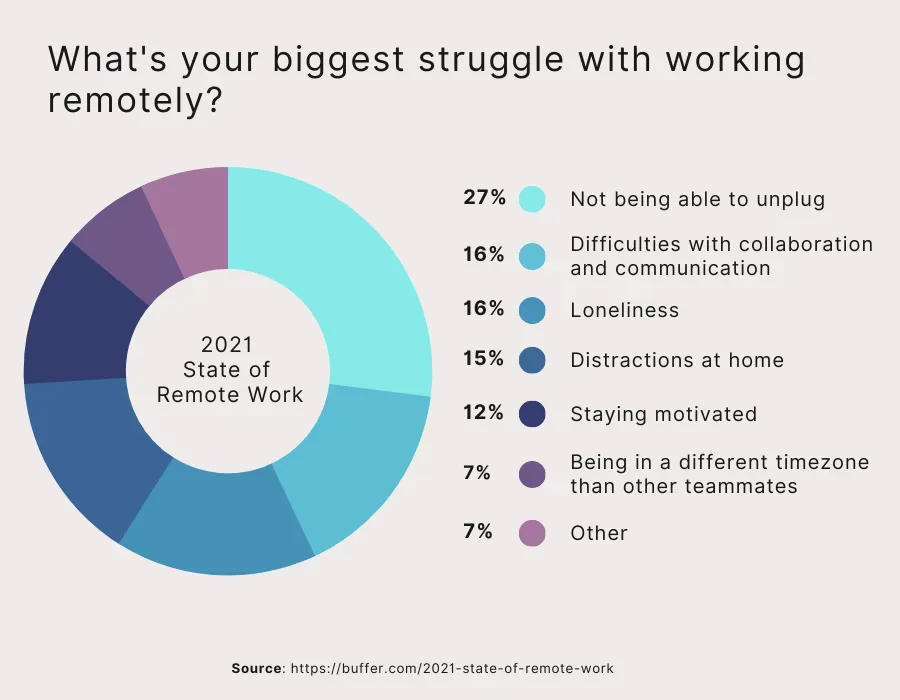Remote Working Strategy: How to Start Working with Remote Teams the Right Way
Starting with remote teams? This guide walks you through building a practical and scalable remote working strategy. From communication to collaboration and team engagement, learn how to support remote employees and set your business up for long-term success.
On this page
Remote work is no longer a temporary shift—it’s a growing phenomenon reshaping the way organizations operate. Some of the world’s largest companies, including Spotify and Quora, have embraced flexible work policies that allow employees to choose where they work from—and they’re far from the only ones.
Letting employees work outside the office has opened up new possibilities for improving productivity, saving time, and supporting personal well-being.
In fact, Harvard Business Review found that during the COVID-19 lockdowns, employees working from home spent 9% more time with customers and external partners and 12% less time in meetings.
But remote work isn’t without its hurdles. Miscommunication, lack of structure, project delays, and feelings of isolation can all disrupt performance if left unaddressed. That’s why organizations today need more than just flexible policies—they need well-defined remote work strategies.
A strong remote working strategy focuses on collaboration, communication, culture, and consistency. For companies planning for the future, investing in long term remote work strategies is essential—not just for keeping teams productive, but for building workplaces that can thrive across locations and time zones.
So, how can businesses work effectively with remote teams while reaping the benefits and avoiding the pitfalls? Let’s take a closer look.
7 Successful remote working strategies for long-term
Remote working is about copying your in-office operations from a different location. Here’s how you can develop a long term remote working strategy.
1. Schedule regular catch-ups
Buffer and AngelList publish a new edition of their State of Remote Work report annually. In the 2021 report, 16% of survey participants cited loneliness as their biggest struggle when working remotely. A further 16% said they struggled with communication and collaboration the most.

Companies can reduce the number of employees suffering from these effects by scheduling regular catch-ups. These don’t have to belong. In most cases, 10 minutes per session is probably enough. Moreover, catch-ups can be scheduled periodically; once or twice per week should do the job.
By scheduling regular check-ins, teams can ensure that projects progress without unexpected delays. Moreover, they can build a sense of togetherness and camaraderie—increasing engagement and reducing feelings of isolation.
2. Set clear communication expectations
There are many communications platforms to choose from. According to m.io’s 2019 Workplace Messaging Report, the average surveyed professional used 3.3 workplace chat apps. Moreover, 91% of businesses used a minimum of two messaging apps.
Using more than one messaging app allows teams to fine-tune their communications. Employees can stop important information from getting lost in lengthy email threads, and each platform may serve a unique purpose. However, if teams don’t strategize the communications platforms, managing multiple apps can overwhelm and cause burnout.
Naturally, remote work requires team members to communicate via digital means. To maximize efficiency, teams must ensure that they set clear expectations about which platforms to use for specific forms of communication.
3. Trust your employees
In physical workplaces, trust is one of the most critical factors for companies to keep their employees engaged. Micromanaging and oppressive oversight can have huge implications; 68% of employees in the Workforce Institute’s “Trust in the Modern Workplace” report said that trust directly impacts their daily performance on the job.
Furthermore, performance isn’t the only reason trust is essential. Almost a quarter of employees in the same research said they left a company because they didn’t feel trusted, and departing employees means losing high-quality talent and spending time and money on hiring replacements.
When working remotely, creating a trust-based environment is even more critical. Businesses can achieve this by maintaining transparency on all processes and encouraging open and direct feedback.
Companies will empower employees to produce better work by creating a trusting environment. Team members will also be more likely to share any problems they’re having, which helps solve issues before they become significant.
4. Motivate through recognition
Employees have always wanted more from their jobs than a steady paycheck, and one of the most critical components in employee engagement is recognition.
Recognizing employees’ achievements doesn’t always mean a promotion (though if they’ve consistently produced exceptional work, businesses should consider this). Often, acknowledging and celebrating accomplishments is enough on its own.
When working remotely, it’s good to bring team members together once a week and get everybody to share their most significant wins. Even the little victories are important, and recognizing employees’ commitment and good work will motivate them to go above and beyond.
5. Focus on work and wellness balance
Remote working—and the lack of commuting that comes with it—has freed up many employees to enjoy more leisure time. And as this has happened, the importance of balancing work with personal wellness has become more evident.
While rest is essential outside of work time, it’s equally important during the day. Humans aren’t wired to focus intensely for eight hours, and regular breaks are necessary to ensure that employees can give their all on each task.
The most overlooked workday necessity is taking a lunch break.
Managers need to ensure that team members take several breaks from the screen when working remotely. They should also check in to see that employees get adequate rest and schedule some time to switch off and recuperate. Encouraging rest can result in greater productivity and higher levels of happiness.
6. Get the right software systems in place
Businesses today are blessed by the volume of technology available to simplify workflows and increase efficiency. Reducing as much manual work as possible is vital for companies spread across several locations to make remote working a long-term success.
Areas where companies should consider using software to automate or simplify work processes:
- Project management
- Employee expense management
- Employee benefits
- Employee training
It’s also worth using software to help team members track paid time off and manage sales and marketing analytics. By using technology to streamline workflows and automate processes, remote teams will have more time to focus on critical tasks. For example, an overtime calculator can help you plan your budget and precisely calculate your employees' overtime hours.
7. Fine-tune your remote work strategy to achieve long-term success
Remote work is here to stay, and several companies worldwide have now implemented either wholly or partly remote working agreements. Both businesses and employees can benefit significantly from these structures as long as they prepare accordingly.
Challenges of setting up a remote work strategy
Here's a complete list of challenges of setting up a remote work strategy, along with practical solutions for each:
1. Set clear expectations from the start
Remote teams need structure to stay aligned. Without physical oversight, it’s easy for tasks to fall through the cracks or for roles to blur. Define responsibilities clearly, outline goals, and communicate expectations early. Project management tools like Trello or Asana helps everyone stay on track without constant follow-ups.
2. Make communication intentional and consistent
When everyone works from different places, communication can become too frequent and overwhelming—or too sparse and disconnected. Set clear guidelines on when to use chat, email, or video calls. Schedule regular check-ins, team huddles, and 1:1s to keep the human connection intact while avoiding chaos.
3. Create space for real collaboration
Teamwork doesn’t happen just because people are online. Without the hallway conversations or spontaneous brainstorming sessions, collaboration needs a more thoughtful setup. Use tools like Google Docs, Notion, or Miro to create shared workspaces. Encourage co-creation, and make room for virtual brainstorming to keep ideas flowing.
4. Focus on trust over control
Micromanaging remote employees does more harm than good. Managers may feel unsure without seeing their team in action, but the solution isn’t surveillance—it’s trust. Shift the focus from hours worked to results delivered. Let employees take ownership, while ensuring they have support when they need it.
5. Build a structured remote onboarding experience
Bringing new employees into the fold is trickier without a physical office. A disjointed start can affect long-term engagement. Share a clear remote employee onboarding checklist, introduce them to the team, assign a buddy, and use platforms like Empuls to keep them connected and recognized from day one.
6. Equip teams with the right tech and support
Technology is the backbone of remote work—but it needs to work without hiccups. Make sure new hires receive pre-configured devices, have access to secure logins, and can easily reach IT support. Enforce basic cybersecurity practices like VPNs and password managers to protect company data across remote locations.
7. Keep culture alive across screens
Remote work can dilute culture if you’re not careful. Employees miss out on office rituals, casual chats, and spontaneous fun. Keep the culture alive through virtual celebrations, recognition programs, and informal hangouts. Platforms like Empuls can help reinforce values and bring people together—no matter where they are.
Powering your remote working strategy with connection and clarity
Building a remote working strategy isn’t just about choosing the right tools—it’s about creating a space where employees feel connected, supported, and part of a larger mission. Empuls helps you make that happen by bringing communication, recognition, feedback, and culture into one unified platform.

With features designed specifically for remote and hybrid teams, Empuls transforms day-to-day work into a more human, engaging experience. From celebrating wins to gathering honest feedback, it enables organizations to build a culture that thrives—even when teams are miles apart.
✔ Connect remote teams – Use the social intranet to keep employees informed, aligned, and socially engaged.
✔ Drive meaningful recognition – Make appreciation part of everyday work with peer-to-peer recognition and manager-led awards.
✔ Gather real-time feedback – Launch quick pulse surveys to understand employee sentiment and adjust your approach when needed.
✔ Make onboarding seamless – Welcome new hires with engaging onboarding experiences, digital rewards, and team introductions.
✔ Celebrate milestones remotely – Automate birthdays, anniversaries, and team achievements with personal and timely rewards.
With Empuls, your remote working strategy doesn’t just keep the team functioning—it keeps them connected, motivated, and inspired.
Conclusion
Building trust, encouraging communication, and setting clear expectations are essential if teams want to succeed with remote work. Putting suitable systems in place is also necessary, and so is reminding employees of the importance of rest and their well-being. By meeting these needs, businesses will continue to succeed—no matter where they are.
Empuls omnichannel solutions allow your employees to connect with peers virtually, recognize good work, align with company goals, speak up, be heard, and help shape their company culture.
A platform to truly engage your remote and hybrid workforce through connection, motivation, and feedback.


















